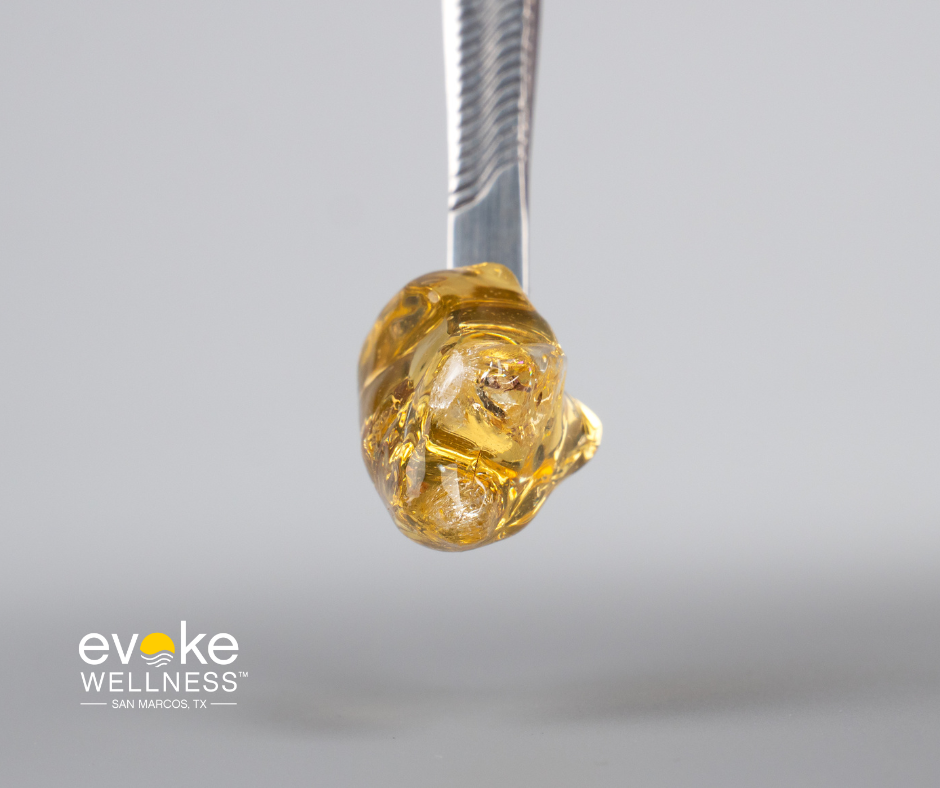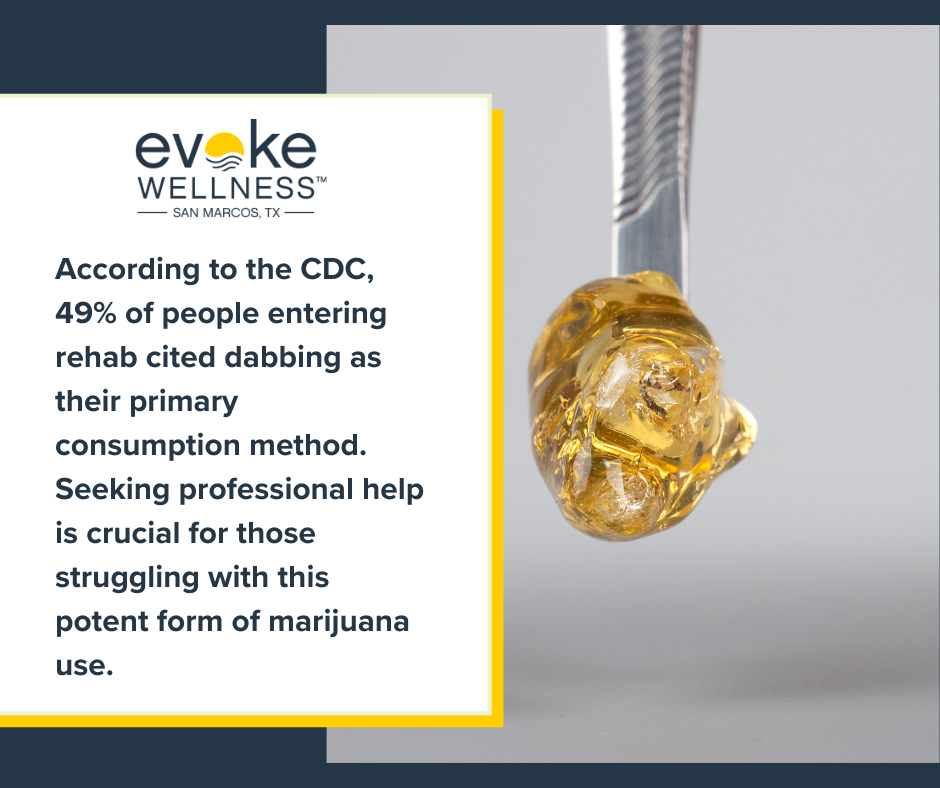You’ve likely heard of dabbing weed, but what exactly is it and why are some calling it dangerous? As cannabis consumption continues growing in popularity, dabbing concentrates like wax, shatter, and butane hash oil have risen over 50% among adults aged 19-30 in recent years. With risks ranging from intense psychoactive effects to lung damage, it’s critical to understand proper usage and potential dangers. As leaders in addiction treatment and holistic wellness, Evoke Wellness helps individuals struggling with substance abuse treatment programs like cognitive behavioral therapy, 12-step recovery, motivational interviewing, and family therapy. By arming yourself with knowledge, you can make informed choices and access support if needed.
Together, let’s embrace the journey to recovery and the promise of a new beginning. Call us at (833) 503-0734 today or reach out online.
What Is Dabbing Weed?
Dabbing weed refers to a method of consuming highly concentrated cannabis extracts by vaporizing them on a hot surface and inhaling the vapors. These extracts, known as dabs or butane hash oil (BHO), contain extremely high levels of THC – the psychoactive compound in marijuana.
The Dabbing Process
- A small amount of the dab is placed on a hot surface, often a special dab rig or an electronic nail
- The intense heat vaporizes the dab into a vapor that is inhaled through a dab rig or vape pen
Potency and Risks
Dabs can contain THC levels as high as 90%, making them far more potent than traditional marijuana flowers. This heightened potency increases the risks of adverse reactions like anxiety, panic attacks, and paranoia. The long-term effects of regularly dabbing high-THC concentrates are not well understood.
The Process of Dabbing
Preparing the Concentrate
- Obtain a dab rig – a specialized water pipe with a nail to vaporize concentrates.
- Select a cannabis concentrate like shatter, wax, or oil with high THC potency.
Heating the Nail
- Use a butane torch to heat the nail until it is glowing red hot.
- Allow the nail to cool slightly until it stops glowing.
Applying the Concentrate
- Use a dab tool to place a small amount of concentrate directly onto the hot nail.
- Inhale slowly to vaporize and consume the dab through the rig’s mouthpiece.
The intense effects from dabbing occur quickly due to the high THC concentration. Proper dosing is crucial, as overconsumption can lead to adverse reactions. Consult professionals for safe, responsible usage.
Types of Cannabis Dabs
Shatter
- A brittle, glass-like concentrate with a translucent amber color. It has a high THC potency of around 80-90%.
Budder/Badder
- Whipped concentrates with a batter-like consistency. They have an opaque, creamy appearance and high potency levels.
Sugar Wax/Crumble
- Soft, honey-like waxes that have a crystallized, crumbly texture. Their THC levels range from 60-80%.
Live Resin
- Concentrates made from fresh, frozen cannabis plants. They retain more terpenes for enhanced flavors and effects.
The potency and effects of dabs vary based on the specific concentrate type and starting cannabis strain. Responsible adult consumers should start with low doses until determining their ideal experience. Proper safety equipment like dab rigs, carb caps, and ventilation are also recommended for dabbing.
Safety and Dabbing
Know the Risks
Dabbing involves vaporizing and inhaling concentrated cannabis extracts or resins. These potent products often contain extremely high THC levels—up to 90% or more. Excessive dosing can increase risks like anxiety, paranoia, and impaired coordination.
Use Proper Equipment
Dabbing requires specialized equipment like dab rigs, nails/bangers, and butane torches. Improper setup or overheating surfaces could lead to burns, fires, or inhaling harmful fumes. Only use products designed for dabbing from reputable sources.
Start Low and Go Slow
Due to the high potency, always start with an extremely small amount when trying a new dab product. Wait at least 15-20 minutes before consuming more to gauge the full effects. Going slowly reduces overconsumption risks.
Physiological and Psychological Effects of Dabbing
Physical Effects
The high potency of dabs can lead to intense physical effects. Common ones include:
- Rapid heartbeat
- Bloodshot eyes
- Dry mouth
- Dizziness or nausea
Mental Impacts
Dabbing high-THC concentrates also carries psychological risks like:
- Paranoia
- Anxiety or panic attacks
- Impaired memory
- Hallucinations (with very high doses)
Dependency Risks
Due to the potency, dabs may increase dependency faster than traditional cannabis use. Signs of problematic use include:
- Needing increasing amounts to feel high
- Inability to cut back despite trying
- Giving up other interests or activities
Dabs deliver extremely concentrated doses of THC. While effects intensify, so do the potential physiological and psychological risks involved with this method of cannabis consumption.
Dabbing vs Other Methods of Consuming Cannabis
Potency and Effects
Dabbing involves inhaling highly concentrated cannabis extracts or oils that can contain up to 90% THC. This results in more intense, immediate effects compared to smoking dry herb. The high is typically shorter but more potent.
Health Considerations
While dabbing may reduce exposure to carcinogenic compounds from burning plant matter, there are safety concerns. Improper extraction techniques can leave residual solvents. Extremely high THC levels also increase risks like anxiety, paranoia and addiction.
Discretion and Odor
One advantage of dabbing is that it produces very little odor or smoke compared to smoking cannabis flower. This makes it more discreet for some users. However, the strong effects mean discretion around others is still advised.
Cost and Accessibility
Cannabis concentrates used for dabbing tend to be more expensive than dry herb. Necessary equipment like rigs, nails and torches also add costs. However, legalization is increasing concentrate availability.
In summary, dabbing offers a potent, discrete way to consume cannabis but also carries unique health risks and financial costs versus other methods like smoking dry herb.
What Is Dabbing Weed | Substance Abuse Treatment Program | 12 Step Recovery Program | Holistic Therapy | Cognitive Behavioral Therapy
Dabbing involves inhaling highly concentrated marijuana extracts or oils heated to extremely high temperatures. This method delivers THC more potently and rapidly than traditional smoking.
Dangers of Dabbing
- Can contain over 80% THC levels (vs 10-25% in regular marijuana)
- Increased risk of adverse reactions like anxiety, psychosis
- Potential for addiction and withdrawal effects
Treatment Options
- Substance abuse treatment programs
- 12 step recovery program
- Holistic therapy (meditation, yoga, etc.)
- Cognitive behavioral therapy
- Dialectical behavior therapy
- EMDR therapy
- Motivational interviewing
- Family therapy program
Conclusion
While dabbing weed may seem harmless to some, the risks and realities of this concentrated form of cannabis should not be underestimated. As substance abuse rises, effective treatment programs can help those struggling with addiction find the path to recovery. Whether it be 12-step programs, therapy modalities like CBT and DBT, or a tailored mix, support is available. By choosing compassion and care, individuals and communities can reduce the harm caused by the abuse of marijuana and its high-potency derivatives. There is hope for a brighter future if we work together to understand the risks and get help when it is needed.
Begin Your Journey with Evoke Wellness at San Marcos
If you or a loved one is considering treatment, Evoke Wellness at San Marcos invites you to contact us. Our compassionate team is ready to answer your questions, discuss your needs, and help you take the first steps toward recovery. At Evoke Wellness, you will find more than just a treatment program – you’ll discover a community dedicated to your wellness and success. Together, let’s embrace the journey to recovery and the promise of a new beginning. Call us at (833) 503-0734 today or reach out online.



